The MSI B450 Tomahawk Motherboard Review: More Missile Than Axe
by Gavin Bonshor on December 11, 2018 8:00 AM EST- Posted in
- Motherboards
- AMD
- MSI
- Zen
- AM4
- Ryzen
- Tomahawk
- Ryzen 2
- B450
- Entry Level
- MSI B450 Tomahawk
System Performance
Not all motherboards are created equal. On the face of it, they should all perform the same and differ only in the functionality they provide - however, this is not the case. The obvious pointers are power consumption, but also the ability for the manufacturer to optimize USB speed, audio quality (based on audio codec), POST time and latency. This can come down to manufacturing process and prowess, so these are tested.
Power Consumption
Power consumption was tested on the system while in a single ASUS GTX 980 GPU configuration with a wall meter connected to the Thermaltake 1200W power supply. This power supply has ~75% efficiency > 50W, and 90%+ efficiency at 250W, suitable for both idle and multi-GPU loading. This method of power reading allows us to compare the power management of the UEFI and the board to supply components with power under load, and includes typical PSU losses due to efficiency. These are the real world values that consumers may expect from a typical system (minus the monitor) using this motherboard.
While this method for power measurement may not be ideal, and you feel these numbers are not representative due to the high wattage power supply being used (we use the same PSU to remain consistent over a series of reviews, and the fact that some boards on our test bed get tested with three or four high powered GPUs), the important point to take away is the relationship between the numbers. These boards are all under the same conditions, and thus the differences between them should be easy to spot.
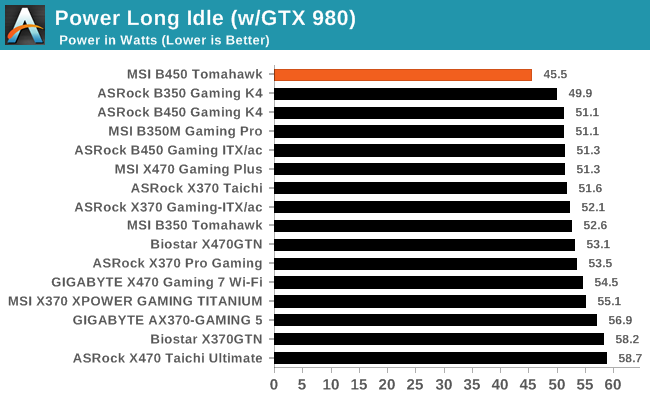
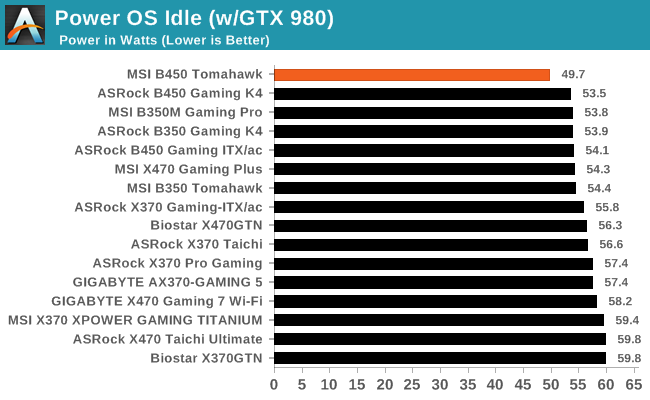
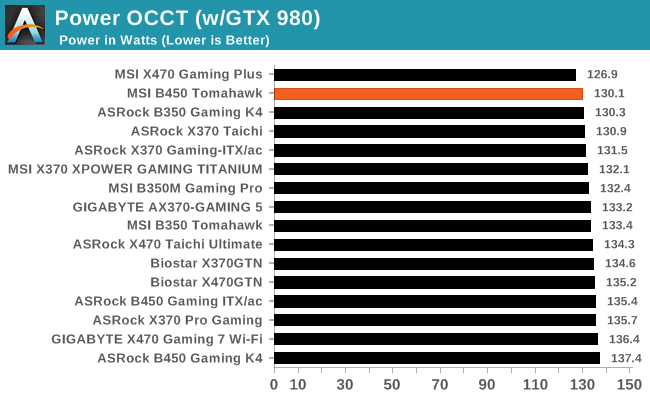
While it wasn't as apparent in our ASRock B450 Gaming ITX/ac and B450 Gaming K4 motherboard reviews, the newer B450 chipset has an idle power draw of only 2 W which really shows in the testing of the B450 Tomahawk. Even at full load the B450 Tomahawk performs well in regards to power consumption and like the X470 Gaming Plus, currently reigns supreme albeit marginally over the ASRock B350 Gaming K4.
Non-UEFI POST Time
Different motherboards have different POST sequences before an operating system is initialized. A lot of this is dependent on the board itself, and POST boot time is determined by the controllers on board (and the sequence of how those extras are organized). As part of our testing, we look at the POST Boot Time using a stopwatch. This is the time from pressing the ON button on the computer to when Windows starts loading. (We discount Windows loading as it is highly variable given Windows specific features.)
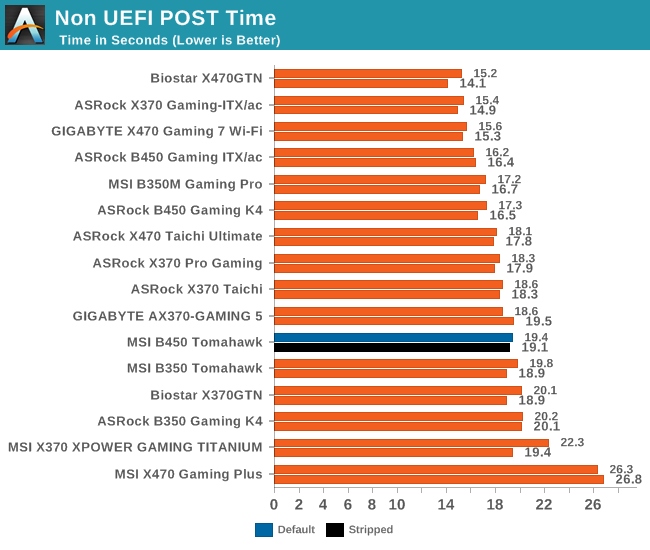
Having tested five MSI AM4 models so far and even an X399 (MEG X399 Creation) model, the consensus so far is that MSI boards have very erratic booting times. Some perform decently, such as the MSI B350 Gaming Pro, and others like the MSI X470 Gaming Plus have much longer POSTing times. The B450 Tomahawk as it stands performs averagely and offers the same sort of performance as the board it replaces.
Rightmark Audio Analyzer 6.2.5
Rightmark:AA indicates how well the sound system is built and isolated from electrical interference (either internally or externally). For this test we connect the Line Out to the Line In using a short six inch 3.5mm to 3.5mm high-quality jack, turn the OS speaker volume to 100%, and run the Rightmark default test suite at 192 kHz, 24-bit. The OS is tuned to 192 kHz/24-bit input and output, and the Line-In volume is adjusted until we have the best RMAA value in the mini-pretest. We look specifically at the Dynamic Range of the audio codec used on the rear panel of the board.

As it was previously stated in the visual inspection, one of the negative differentials between the first and second generation AM4 B350/B450 Tomahawk models is the audio area of the PCB. MSI has clearly done away with over half of the Nippon Chemicon gold audio capacitors and whether that's had a detrimental effect or not on the B450 Tomahawk, our testing shows that the B450 Tomahawk performs the worst out of all the Realtek ALC892 equipped boards thus far.
DPC Latency
Deferred Procedure Call latency is a way in which Windows handles interrupt servicing. In order to wait for a processor to acknowledge the request, the system will queue all interrupt requests by priority. Critical interrupts will be handled as soon as possible, whereas lesser priority requests such as audio will be further down the line. If the audio device requires data, it will have to wait until the request is processed before the buffer is filled.
If the device drivers of higher priority components in a system are poorly implemented, this can cause delays in request scheduling and process time. This can lead to an empty audio buffer and characteristic audible pauses, pops and clicks. The DPC latency checker measures how much time is taken processing DPCs from driver invocation. The lower the value will result in better audio transfer at smaller buffer sizes. Results are measured in microseconds.
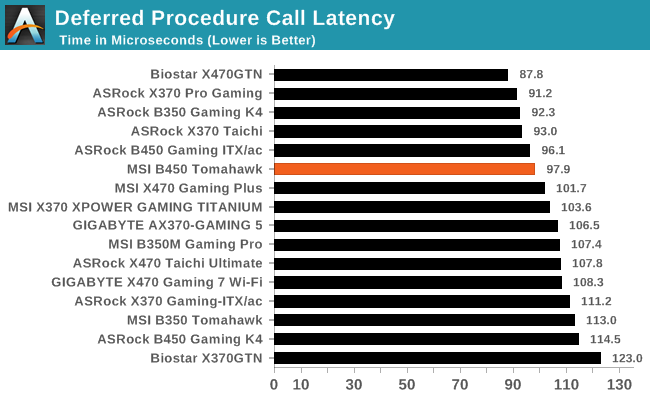
As with all of the AM4 motherboards tested so far, none of them has been super optimized for DPC latency and the B450 Tomahawk is no different in this regard. It still puts in a respectful showing, scoring a smidge under 100 microseconds.










36 Comments
View All Comments
kn00tcn - Sunday, December 16, 2018 - link
buildzoid has said gigabyte went backwards in memory support for their second gen mobos16gb sticks are more demanding, 32gb total is more demanding
you dont 'need' to buy bdie, but you should be aware of various aspects that can hurt stability
XMP doesnt mean much, the secondary timings are not in the profile, the mobo has to make them up, the mobo may not even be sending clean or high enough voltage, the mobo can cause multiple problems already & that's before the cpu's memory controller variance is even looked at
plonk420 - Friday, December 14, 2018 - link
yeah, i got the B450M Mortar on the suggestion of Buildzoid and am loving it! took my VRM temps at 1700X stock speeds from 87C on the AB350M-DS3H with its wickle cooler to 65C on the Mortarkn00tcn - Sunday, December 16, 2018 - link
if you're still around to read this, i have booted a mortar to 3466 on hynix m-die (gskill trident z 2x8gb) with mostly auto settings, but it was unstable of course (not like i expect hynix to run at this speed at c16)how can you refuse to believe something you have no statistics on? what cpu was it? 32gb is more demanding than 16gb, dual rank is more demanding than single rank (rank not channel, 16gb sticks are likely dual rank)
try 2T CR, try geardown & bankgroup enabled, try 1.36 or 1.37v, try 1.1v soc
kn00tcn - Sunday, December 16, 2018 - link
*using 2600x cpu, stock coolerrocky12345 - Monday, December 17, 2018 - link
I'm not sure it is the retailers fault that the board is not working for you now. They did not do a bios flash and render the board dead now did they. When you installed the board yes it had problems seeing both of your memory sticks and that was because of it having a older bios firmware installed.The fault is that of MSI them selves for having a newer bios that does not seem to be working properly on this model of board. With all of that said the most the retailer can do is offer to take the board in and try to get it working for you and if they are nice won't charge you anything or if they do want to charge maybe a really small fee (since it was them that flashed the board making it useless now.)
As a retailer myself I would offer to take the board in and get it working for free. My own thoughts are because of the board first having issues with your memory sticks on the older bios that is where the problem is. If they took the board in and tried to fix it any good tech with that information in hand would very quickly pull your memory out and use actual memory that is known to work with these boards without problems and then do the flashback again. Chances are that is when the problem will be corrected and you would have a fully functioning board again.
I do think it is good of you not to mention names at this point. I do think that if they have a decent tech on staff this should be a easy fix for them and get you running again. Now if you just want to return the board for the sake of returning it then that is up to them if they want to do that or not. The board is either going to end up fixed or sent back to MSI for replacement. Now if it does end up going back to MSI who pays for the shipping MSI,the retailer or you that is the question.
0ldman79 - Tuesday, December 11, 2018 - link
Can you overclock using p-states with this board?I still use all of the various power saving features on all of my systems, my FX, my Core i5, i7 and Xeon and all but the laptops are overclocked.
I guess I got spoiled with my FX, I could alter base, turbo 1 and turbo 2 settings individually and keep Cool-n-quiet enabled. I'm looking for that capability on my eventual Ryzen build as well.
kn00tcn - Sunday, December 16, 2018 - link
should be some sort of PBO settingsCellar Door - Tuesday, December 11, 2018 - link
The audio on this board is absolute trash. Not even bad, terrible. It is muddy and with such poor amplification that if you have even an entry pair of headphones such as Audio Technica ATH-M50, you will be barely able hear stuff, and outright forget any soundstage or bass definition.I had no choice but to exchange it for a Asus B450-F - well worth the extra $25. In my 20 years in IT - I've seen better audio on 10 year old prebuilt Dell and no name PCs. MSI should be ashamed they are putting a 'gaming' sticker on this.
gavbon - Wednesday, December 12, 2018 - link
I had no issues with my Beyerdynamic DT770's 80ohm pair of cans.Cellar Door - Wednesday, December 12, 2018 - link
From this review - "our testing shows that the B450 Tomahawk performs the worst out of all the Realtek ALC892 equipped boards thus far."83.5db in the dynamic range - no offense but either those DT770 are being wasted on you or you never actually hear what they are capable of when properly amplified.